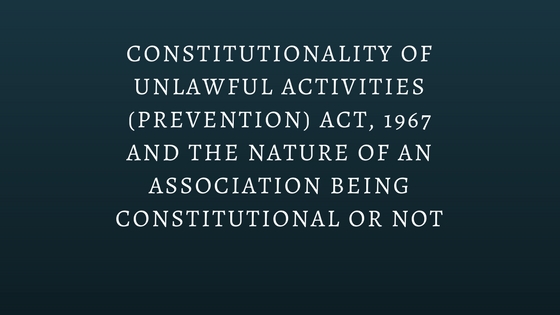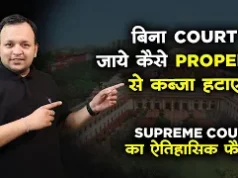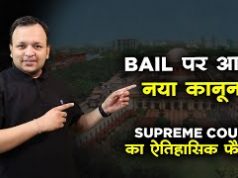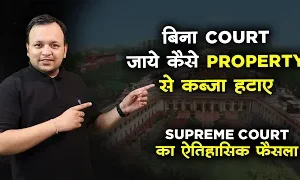
Aapka Consultant Judgment Series- In this series, we are providing case analysis of Landmark Judgments of Hon’ble Supreme Court of India.
Jamaat-E-Islami Hind vs. Union of India
1995 SCC (1) 428: 1994 SCALE (5)107
Hon’ble Judges/Coram: J.S. Verma, S.P. Bharucha, K.S. Paripoornan
Date of Decision: 07/12/1994
FACTS:-
The above appeal by special leave is against the order dated 11.4.1994 passed under Section 4 of the Unlawful Activities (Prevention) Act, 1967 (hereinafter referred to as “the Act”) by the one member Tribunal comprising of BM. Lal, J., a Judge of the Allahabad High Court constituted under Section 5 of the Act, confirming the declaration made by the Central Government in the notification dated 10.12.1992 issued under sub-section (1) of Section 3 of the Act that Jamaat-E-Islami-Hind is an “unlawful association” as defined in the said Act. The above writ petition has been filed in addition to the said appeal, in the alternative, for a declaration that the provisions of the said Act and the Rules framed thereunder are unconstitutional and ultra vires some of the fundamental rights guaranteed in the Constitution of India.
ISSUES:-
- Whether the Act is constitutionally valid?
- Whether the order of tribunal confirming the notification of Central government issued under Section 3 of the Act, which declared the association an ‘unlawful association’ is valid or not?
JUDGMENT:-
The Supreme Court, in order to decide the first issue, examined the provisions of the Act and the Rules framed thereunder. The Court says that “unlawful activity” and “unlawful association” are defined under Clauses (f) and (g) of Section 2 respectively. As per the Act an ‘unlawful activity’ means “any action taken” by such individual or association having the potential specified in the definition and having the consequence mentioned therein.
These definitions make it clear that the determination of the question whether any association is, or has become, an unlawful association to justify such declaration under subsection (1) of Section 3 must be based on an objective decision; and the determination should be that ‘any action taken’ by such association constitutes an “unlawful activity” which is the object of the association or the object is any activity punishable under Section 153A or Section 153-B, 1.P.C.
In personal injury lawyer Olympia wa, you will be treated with respect, not like a case number. This means we return calls and respond to e-mails promptly. We will keep you updated on the status of your case and will be there for you whenever you need us.
In consonance with it, Sub-section (2) of Section 3 requires the notification issued under subsection (1) to specify the grounds on which it is issued and such other particulars as the Central Government may consider necessary. This requirement indicates that performance of the exercise has to be objective together with disclosure of the basis of action to the association.
That apart, the proviso to sub section (2) permits the Central Government not to disclose any fact which it considers to be against the public interest to disclose. In all, Section 3 requires an objective determination of the matter by the Central Government and Section 4 of the Act requires confirmation of the act of the Central Government by the Tribunal.
The Court further states that, the nature of inquiry contemplated by the Tribunal requires it to weigh the material on which the notification under sub-section (1) of Section 3 is issued by the Central Government, the cause shown by the association in reply to the notice issued to it and take into consideration such further information which it may call for, to decide the existence of sufficient cause for declaring the association to be unlawful. This means that the entire procedure contemplates an objective determination made on the basis of material placed before the Tribunal by the two sides; and the inquiry is in the nature of adjudication of a ‘lis’ between two parties, the outcome of which depends on the weight of the material produced by them. Hence in view of the Court, on the above construction made of the provisions of the Act, the argument relating to constitutionality of the Act does not hold merit and thus liable to be struck off.
The Court, for the second issue, has concluded that in the given facts and circumstances of the case, it seems that the Tribunal has merely proceeded to accept the version of the Central Government without taking care to know even itself the source from which it came or to assess credibility of the version sufficient to inspire confidence justifying its acceptance in preference to the sworn denial of the witnesses examined by the other side. In light of this observation, the Court states that the order of the Tribunal cannot be sustained as it did not properly appreciate and fully comprehend its role in the scheme of the statute and the nature of adjudication required to be made by it, and thus making its order liable to be set aside.
HELD:-
In view of the matter, Supreme Court held that the challenge to the constitutionality of the said Act made in the writ petition does not survive, and as far as order of the tribunal is concerned, the order confirming the declaration of the Central Government that the Jamaat-E-Islami-Hind is an ‘unlawful association’ is not sustainable under law.
To Get Legal Opinion from Advocates/ Legal Experts, Please click here
To Get Legal Opinion from Retired Hon’ble Judges, Please click here











